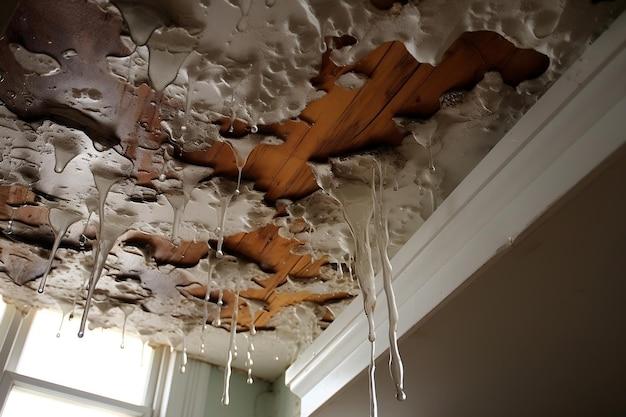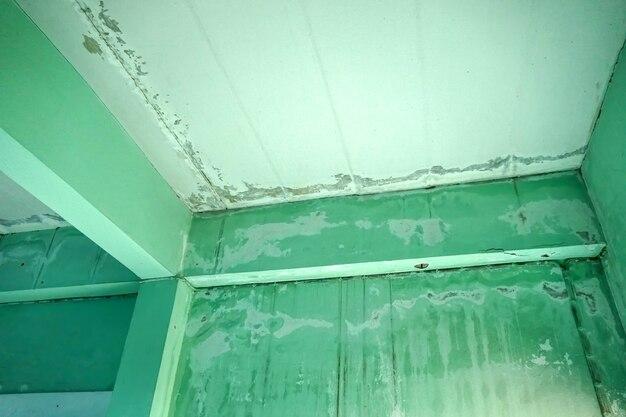A leaking ceiling can be a cause for concern and raise numerous questions about its potential dangers. You might wonder if a wet ceiling can collapse, if water damage always leads to mold, or if insurance covers such incidents. In this blog post, we will address these queries and provide you with valuable information to understand the risks associated with a wet ceiling.
From assessing the dangers of a leaking ceiling to determining the need for replacing wet ceiling drywall, we will cover various aspects related to water damage. Additionally, we will explore the causes of ceiling collapse and discuss preventive measures to avoid such a catastrophic event. Whether you’ve noticed cracks in your ceiling or have found water seeping through, it’s essential to understand the potential risks and take appropriate actions to protect your home and loved ones.
So, if you’re concerned about the possibility of your ceiling collapsing due to water damage or want to learn how to handle a leak, this blog post is for you. Read on to gain insights into the consequences of a wet ceiling and discover the steps you can take to address the situation effectively.
Can a Wet Ceiling Collapse
Water damage is a homeowner’s worst nightmare. From leaky pipes to heavy rainstorms, water has a sneaky way of finding its way into our homes. But what happens when water infiltrates our ceilings? Can a wet ceiling actually collapse? Let’s dive into this damp dilemma!
Understanding the Risks
When water seeps into a ceiling, it can weaken the structural integrity of the building materials. The moisture can cause the ceiling to sag and become unstable, increasing the risk of collapse. So, it’s crucial to tackle any signs of water damage promptly to prevent further complications.
Signs of Trouble
If you notice a wet spot on your ceiling, it’s time to get Sherlock Holmes on the case! Look out for bulges, discoloration, or even dripping water. These signs indicate that water has made its way into your ceiling, potentially compromising its stability. Don’t ignore these red flags – act fast to avoid a disastrous outcome!
Factors at Play
Various factors come into play when determining whether a wet ceiling can collapse. The extent of the water damage, the materials used in the ceiling’s construction, and the duration of exposure to moisture all play a role. Additionally, the weight of the water itself can exacerbate the situation. It’s like adding insult to injury!
Seek Professional Help
When dealing with a wet ceiling, don’t be a DIY daredevil. It’s essential to call in the professionals, such as experienced contractors or water damage restoration specialists. They have the expertise and tools to assess the damage accurately and provide the necessary repairs. Remember, safety comes first!
Preventative Measures
To avoid a wet ceiling disaster in the first place, regular maintenance is key. Keep an eye out for any signs of leaks or water damage, and address them promptly. Ensure proper insulation and ventilation to reduce the risk of moisture build-up. Remember, an ounce of prevention is worth a pound of cure (and a collapsed ceiling)!
While a wet ceiling doesn’t necessarily mean imminent collapse, it’s not a situation to be taken lightly. Understand the risks, look out for warning signs, and take appropriate action to prevent further damage. Always seek professional help and prioritize regular maintenance to keep your ceiling dry and your worries at bay. After all, no one wants a surprise shower from above!
FAQ: Can A Wet Ceiling Collapse
How dangerous is a leaking ceiling
A leaking ceiling can be quite dangerous, especially if left unattended. Not only can it lead to structural damage and the potential for a ceiling collapse, but it can also create a breeding ground for mold and mildew. Therefore, it’s crucial to address a leaking ceiling as soon as possible.
Does wet ceiling drywall need to be replaced
In many cases, wet ceiling drywall will need to be replaced. Once drywall becomes saturated with water, it loses its strength and integrity. Additionally, wet drywall can provide an environment for mold growth. Therefore, it’s best to remove and replace any wet ceiling drywall to ensure the structural safety of your home.
Can a ceiling suddenly collapse
While the chances of a ceiling suddenly collapsing are relatively low, it’s not entirely impossible. A ceiling weakened by water damage or structural issues may reach a point where it can no longer support its weight, leading to a potential collapse. It’s essential to address any signs of damage promptly to prevent such a situation.
Should I be concerned about cracks in the ceiling
Cracks in the ceiling may indicate underlying structural issues or water damage. While small, hairline cracks are generally harmless, larger or expanding cracks should be a cause for concern. It’s advisable to have a professional assess the situation to determine the severity and potential risks associated with the cracks.
Does water damage always cause mold
Water damage does not always lead to mold growth. However, the presence of moisture provides an ideal environment for mold spores to thrive. If left unchecked, mold can pose significant health risks and further damage to your home. It’s crucial to address water damage promptly to mitigate the risk of mold growth.
Does insurance cover ceiling collapse
Whether your insurance covers a ceiling collapse depends on your specific policy. Some homeowner’s insurance policies may provide coverage for sudden and accidental damage, including ceiling collapses caused by water damage or structural issues. Review your policy carefully or consult your insurance provider to understand the coverage available to you.
What do I do if there’s water in my ceiling
If you discover water in your ceiling, it’s essential to take immediate action. Start by locating the source of the water and shutting off the water supply if necessary. Then, contact a professional plumber or a water damage restoration company to assess and mitigate the damage. Quick intervention can prevent further water infiltration and minimize potential risks.
How long does it take for a ceiling to collapse from water damage
The time it takes for a ceiling to collapse from water damage can vary depending on various factors, such as the extent of the damage, the structural integrity of the ceiling, and the presence of any additional support. In some cases, a ceiling weakened by water damage may collapse within hours or days, while in others, it may take weeks or even longer. Promptly addressing water damage is vital to prevent a potential collapse.
Can a ceiling collapse from water
Yes, a ceiling can collapse from water damage, especially if the water saturates the ceiling material, compromises its integrity, and weakens its structural support. Moisture can cause drywall to become soft and unstable, potentially leading to the collapse of the ceiling above.
What is the best filler for ceiling cracks
To fill ceiling cracks, you can use a quality joint compound or spackling paste. These products are readily available at most hardware or home improvement stores. Follow the manufacturer’s instructions for proper application and ensure the area is adequately prepared before applying any filler.
How much does it cost to replace a kitchen ceiling
The cost to replace a kitchen ceiling can vary depending on factors such as the size of the ceiling, the materials used, and the complexity of the project. On average, homeowners can expect to spend between $1,500 and $3,000 for a kitchen ceiling replacement, including materials and labor. However, it’s best to obtain quotes from contractors in your area for a more accurate estimate.
How much does a ceiling cost to replace
The cost of replacing a ceiling depends on several factors, including the size of the ceiling, the type of material used, the extent of the damage, and the complexity of the project. On average, homeowners can expect to spend between $1,000 and $3,000 for a standard ceiling replacement. However, it’s crucial to consult with contractors to get specific quotes based on your unique situation.
How do you cover a sagging ceiling
Covering a sagging ceiling requires addressing the underlying issue causing the sag. It’s essential to determine if the sag is due to water damage, structural issues, or improper installation. Once the cause is identified, consult a professional to determine the appropriate corrective action, whether it’s repairing the existing ceiling or installing a new one.
How much does it cost to fix a ceiling leak
The cost to fix a ceiling leak can vary depending on the cause and extent of the damage. Minor leaks may only require a simple repair, which can cost around $200 to $500. However, more significant water damage or structural issues may require extensive repairs, which can range from $500 to $1,500 or more. It’s best to consult with a professional to assess the specific situation and provide an accurate estimate.
How do you stop a leaking ceiling
To stop a leaking ceiling, you must first identify and address the source of the leak. This may involve fixing plumbing issues, repairing roof damage, or sealing gaps and cracks in the ceiling or walls. Once the source is resolved, you can take steps to dry the affected area, repair any damage, and prevent future leaks, such as applying a waterproof sealant.
What can cause a ceiling to collapse
Several factors can cause a ceiling to collapse, including:
- Water damage: Prolonged water infiltration can weaken the ceiling material, compromising its integrity over time.
- Structural issues: Poor construction, inadequate support, or damage to load-bearing components can lead to a ceiling collapse.
- Excessive weight: Overloading the ceiling with heavy items or structural modifications without proper reinforcement can cause it to collapse.
- Natural disasters: Earthquakes, severe storms, or other natural events can exert significant force on the ceiling, potentially causing it to collapse.
How do you stop a ceiling from collapsing
To prevent a ceiling from collapsing, it’s crucial to address any signs of damage or structural issues promptly. Regular inspections and maintenance can help identify potential problems early on. Additionally, avoid overloading the ceiling with excessive weight and ensure proper support for any modifications or additions. Taking preventive measures and addressing issues promptly can help maintain the integrity and safety of your ceiling.
How do you know if your ceiling is going to collapse
While it can be challenging to predict a ceiling collapse, several warning signs may indicate an imminent risk:
- Sagging or bowing ceiling
- Persistent leaks or water stains
- Cracks or visible damage in the ceiling
- Audible creaking or popping sounds
- Structural movement or shifting
If you notice any of these signs, it’s crucial to consult with a professional to assess the situation and take appropriate action to prevent a potential collapse.

